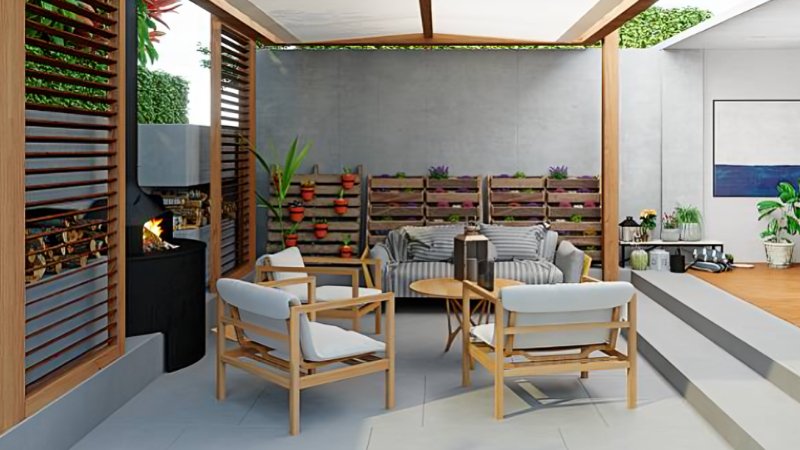People have begun to rediscover the dual benefits of outdoor activities, which enhance both their mental well-being and physical health. The combination of sunlight, fresh air, and open areas produces stress relief and mental clarity, providing a welcome break from digital work-related tasks.
Home design development now places equal importance on outdoor comfort spaces as it does on indoor design elements. The modern design trend transforms patios from their original function as grilling areas into versatile spaces that support a range of activities, including dining, work, exercise, and relaxation. People now focus on creating spaces that will remain useful throughout the entire year.
New materials and design approaches have emerged in the market, driving the evolution of outdoor spaces. Homeowners can now create personalized outdoor spaces using weather-resistant fabrics, modular furniture systems, and adaptable shade solutions. People aim to create outdoor spaces that blend naturally with their living areas through functional design.
An outdoor pavilion stands as a transformative element for outdoor spaces. The structure serves as a protective, roofed area that creates defined spaces while providing shade and improving functionality. A pavilion transforms vacant yard areas into comfortable spaces by uniting design elements with functional value.
The design solution unites comfort elements with visual appeal and functional requirements to create an inviting outdoor retreat.
Establishing a Perfect Outdoor Area Requires a Proper Foundation
Every outdoor retreat requires a strong base before designers can focus on visual elements. The first step in creating an outdoor space is to understand its intended usage.
Do you want to build a peaceful reading area or establish a busy social gathering space? The design should include provisions for shade protection, privacy features, and weather resistance for year-round accessibility.
Every decision about furniture arrangement and floor selection should support the intended purpose of the space. The connection between your home’s interior and outdoor areas requires careful planning. A well-designed transition creates a seamless experience, making you feel as though you’ve entered a new room instead of stepping outside your home.
The selection of materials for outdoor spaces requires attention to their ability to withstand environmental conditions. The selection of durable materials for outdoor spaces includes stone and concrete, pressure-treated wood, and composite decking, but the optimal choice depends on your location and maintenance habits.
Plants serve as effective boundary markers, creating distinct environmental moods that range from tropical lushness to desert minimalism.
Design Tips for a Seamless Outdoor Retreat
The next step after building your structure involves selecting design elements that will enhance the overall experience. Several design elements can help you create an inviting outdoor space with a unified appearance.
Layer Your Lighting
The combination of ambient lighting, task lighting, and accent lighting creates depth and atmosphere in a space. String lights with soft illumination create a peaceful atmosphere, yet solar pathway lights provide both functionality and decorative value.
Incorporate Natural Textures
The combination of wood, stone, and greenery elements creates an organic design that achieves equilibrium. The use of natural materials produces a calming effect on architectural features while establishing a sense of stability in the space.
Create Flexible Zones
Different areas within your outdoor space can be established through the strategic placement of rugs, planters, and furniture arrangements, which create separate zones for dining, lounging, and meditation. The ability to adjust the space configuration makes it suitable for various activities at different times of the day.
Think Seasonally
Your outdoor space becomes more functional in various weather conditions through the use of curtains, screens, and retractable panels, which help manage light and temperature.
Sustainability and Longevity in Outdoor Living Design
Outdoor design requires both aesthetic appeal and environmental responsibility. Your retreat will maintain its beauty while upholding ecological responsibility through the use of sustainable materials
and green construction methods.
Select wood products from local sources or composite materials that demonstrate resistance to rotting. Plants native to your area should be selected because they need minimal care and water. Solar-powered lighting and rainwater collection systems provide environmentally friendly solutions for your outdoor space.
A thoughtfully designed outdoor space offers both an improved quality of life and long-term value appreciation for your property. Homebuyers actively seek properties with carefully designed outdoor areas that expand their living spaces.
Design That Invites You In — and Out
Outdoor design allows people to experience timeless elements, including natural patterns and expansive spaces, as well as the inherent joy of spending time outdoors. A backyard that matches your personality and way of life transforms into a living space that goes beyond its basic function as just grass or a patio area. Your outdoor space transforms into an active component that enhances your home’s overall presence.
Great design starts with purposeful planning when you want to create either a small seating area or an elaborate pavilion with architectural details. The actual value of outdoor design lies in creating spaces that invite you and your loved ones to stay outside for extended periods, rather than focusing solely on construction quantity.
